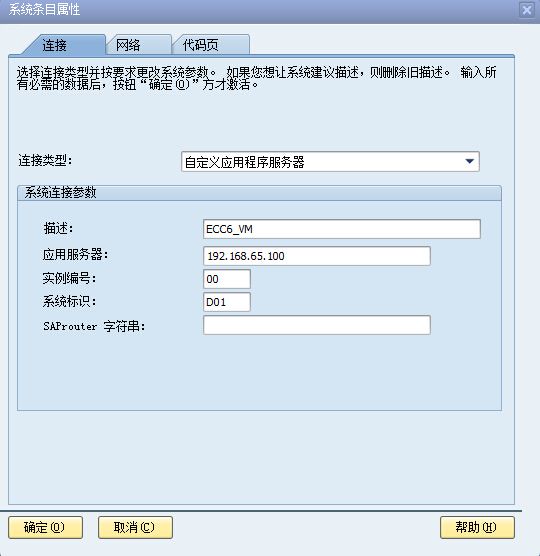JCo3.0 是 Java 语言与 ABAP 语言双向通信的中间件。与之前版本 1.0/2.0 相比,是重新设计的产品。API 和架构设计与 NCo3.0 比较类似。前面也说过,NCo3.0 的设计参考了 JCo3.0。从本篇开始,系统性介绍 JCo3.0 程序编写的技术要点。
JCo3.0 安装
从 https://service.sap.com/connectors 下载 JCo3.0,注意下载的时候根据操作系统和 JVM 版本(32 位还是 64位)选择不同的版本。安装就是解压,将文件解压到目标文件夹。以 Windows 系统为例,主要的文件包括:
- sapjco3.dll
- sapjco3.jar
SAP 强烈推荐将这两个文件放在同一文件夹下。测试安装是否成功,可以在命令窗口下,进入安装文件夹,运行下面的命令:
java -jar sapjco3.jar
如果安装成功,应该显示类似如下界面:
JCoDestination 对象介绍
JCoDestination 代表后端 SAP 系统,开发人员不必关心与 SAP 的连接,JCo3.0 运行时环境负责连接的管理,包括连接和释放连接。我们先看一个简单的例子,了解 JCo3.0 JCoDestination 类的一些要点。
我使用的编程环境是 Eclipse,环境准备如下:
- 新建一个 Java 项目,项目名为
JCo3Demo。 - 将 sapjco3.jar 加入到项目的 Build Path 中。sapjco3.jar 和 sapjco3.dll 要放在同一个文件夹下。
- 在 Eclipse 项目文件夹下,新建一个文本文件,文件名命名为
ECC.jocdestination,在这个文件中设置 SAP 系统连接的的相关参数。
文件的内容如下:
#SAP Logon parameters!
#Tue Dec 08 16:41:30 CST 2015
jco.client.lang=EN
jco.client.client=001
jco.client.passwd=xxxxxx
jco.client.user=STONE
jco.client.sysnr=00
jco.client.ashost=192.168.65.100
对照 SAP GUI,不难理解各个参数的作用:
环境准备好了,先来一段最简单的代码,测试是否可以连接到 SAP 系统:
package jco3.demo1;
import java.util.Properties;
import org.junit.Test;
import com.sap.conn.jco.JCoDestination;
import com.sap.conn.jco.JCoDestinationManager;
import com.sap.conn.jco.JCoException;
public class JCoDestinationDemo
{
public JCoDestination getDestination() throws JCoException
{
/**
* Get instance of JCoDestination from file named ECC.jcodestination
* which should be located in the installation folder of java project
*/
JCoDestination dest = JCoDestinationManager.getDestination("ECC");
return dest;
}
@Test
public void pingDestination() throws JCoException
{
JCoDestination dest = this.getDestination();
dest.ping();
}
}
代码说明:
getDestination() 方法
getDestination()方法中,JCoDestinationManager.getDestination("ECC") 从 ECC.jcodestination
文件获取连接参数,创建 JCoDestination 对象的实例。
这里有一个重要的约定,JCoDestinationManager.getDestination("ECC")方法,从 Eclipse 项目的根目录,查找 ECC.jcodestination 文件,文件的扩展名必须固定为 jcodestination,文件名就是 getDestination 方法的参数。如果找到文件,从文件中获取连接参数。这是 DestinationDataProvider 接口的一个默认实现,在开发和测试的时候还是很方便的,但如果在真实项目中使用,安全性和灵活性就不够。后续介绍解决方法。
pingDestination() 方法
pingDestination() 方法调用 JcoDestination 对象的 ping() 方法测试与 SAP 系统的连接。
生成配置文件
刚才我们是手工编辑 ECC.jcodestination 文件,因为很多连接参数来自于 DestinationDataProvider 接口,如果想通过代码来创建配置文件,可以使用如下代码:
package jco3.demo2;
import java.io.File;
import java.io.FileNotFoundException;
import java.io.FileOutputStream;
import java.io.IOException;
import java.util.Properties;
import org.junit.Test;
import com.sap.conn.jco.ext.DestinationDataProvider;
public class DestinationFile
{
private Properties setProperties()
{
// logon parameters and other properties
Properties connProps = new Properties();
connProps.setProperty(DestinationDataProvider.JCO_ASHOST, "192.168.65.100");
connProps.setProperty(DestinationDataProvider.JCO_SYSNR, "00");
connProps.setProperty(DestinationDataProvider.JCO_USER, "STONE");
connProps.setProperty(DestinationDataProvider.JCO_PASSWD, "xxxxxx");
connProps.setProperty(DestinationDataProvider.JCO_CLIENT, "001");
connProps.setProperty(DestinationDataProvider.JCO_LANG, "EN");
return connProps;
}
private void doCreateFile(String fName, String suffix, Properties props) throws IOException
{
/**
* Write contents of properties into a text file
* which was named [fName+suffix.jcodestination]
*/
File cfg = new File(fName+"."+suffix);
if (!cfg.exists()){ // file not exists
// Create file output stream, not using append mode
FileOutputStream fOutputStream = new FileOutputStream(cfg, false);
// store the properties in file output stream
// and also add comments
props.store(fOutputStream, "SAP logon parameters:");
fOutputStream.close();
}else{
throw new RuntimeException("File alreay exists.");
}
}
@Test
public void createConfigFile() throws IOException
{
Properties props = this.setProperties();
String fileName = "SAP_AS"; // sap application server
// jcodestination suffix is required by JCoDestinationManager
this.doCreateFile(fileName, "jcodestination", props);
}
}
代码说明:
-
setProperties()方法属性参照DestinationDataProvider类的常量设置Properties 的实例。 -
doCreateFile()方法根据需求的文件名和扩展名在 Eclipse 项目的根文件夹下,创建一个文本文件,文件的内容就是 Properties 实例的内容。 -
createConfigFile()方法,调用上面的两个方法,创建配置文件。
更改配置文件名的路径和扩展名
我们看到,默认情况下,SAP 对配置文件的路径和扩展名都不能改变,如果我们想把文件放在任意位置,扩展名也使用其他的扩展名,有没有办法?答案是有,方法是实现 DestinationDataProvider 接口,并改写
(override) getDestinationProperties() 方法,然后通过Environment.registerDestinationDataProvider() 方法进行注册。
OK, 一起来看看代码,代码分为三个部分:
一、 创建 FileDestinationDataProviderImp 类,实现
DestinationDataProvider 接口;
DestinationDataProvider接口实现的代码:
package jco3.demo2;
import java.io.File;
import java.io.FileInputStream;
import java.io.IOException;
import java.util.Properties;
import com.sap.conn.jco.ext.DestinationDataEventListener;
import com.sap.conn.jco.ext.DestinationDataProvider;
public class FileDestinationDataProviderImp implements DestinationDataProvider
{
private File dir;
private String destName; // destination name
private String suffix;
public void setDestinationFile(File dir, String destName, String suffix)
{
this.dir = dir;
this.destName = destName;
this.suffix = suffix;
}
private Properties loadProperties(File dir, String destName, String suffix) throws IOException
{
Properties props = null;
// create a file with name: fullName in destDirectory
File destFile = new File(dir, destName+"."+suffix);
if (destFile.exists()){
FileInputStream fInputStream = new FileInputStream(destFile);
props = new Properties();
props.load(fInputStream);
fInputStream.close();
}else{
throw new RuntimeException("Destination file does not exist.");
}
return props;
}
@Override
public Properties getDestinationProperties(String destName)
{
Properties props = null;
try {
props = this.loadProperties(this.dir, this.destName, this.suffix);
} catch (IOException e) {
e.printStackTrace();
}
return props;
}
@Override
public void setDestinationDataEventListener(DestinationDataEventListener listener)
{
throw new UnsupportedOperationException();
}
@Override
public boolean supportsEvents()
{
return false;
}
}
二、 创建 FileDestinationDataProvider类,注册FileDestinationDataProviderImp 的实例,并提供 getDestination() 方法供调用。代码如下:
package jco3.demo2;
import java.io.File;
import com.sap.conn.jco.JCoDestination;
import com.sap.conn.jco.JCoDestinationManager;
import com.sap.conn.jco.JCoException;
import com.sap.conn.jco.ext.Environment;
public class FileDestinationDataProvider
{
public static JCoDestination getDestination() throws JCoException
{
File directory = new File("."); // current directory;
String fileName = "SAP_AS";
String suffix = "txt";
FileDestinationDataProviderImp destDataProvider = new FileDestinationDataProviderImp();
destDataProvider.setDestinationFile(directory, fileName, suffix);
Environment.registerDestinationDataProvider(destDataProvider);
JCoDestination dest = JCoDestinationManager.getDestination(fileName);
return dest;
}
}
我们看到,getDestination 方法中,文件的路径,文件的扩展名,都是我们自己定义的。文件名作为 JCoDestinationManager.getDestination 方法的 destination name 参数。从这里也可可以看到,JCoDestinationManager.getDestination 方法从哪里查找连接参数,是依赖于 Environment 注册的 DestinationDataProvider 实现。
三、调用 FileDestinationDataProvider 类的 getDestination() 方法。代码如下:
package jco3.demo2;
import org.junit.Test;
import com.sap.conn.jco.JCoDestination;
import com.sap.conn.jco.JCoException;
public class TestFileDestinationProvider
{
@Test
public void pingSAPDestination() throws JCoException
{
JCoDestination dest = FileDestinationDataProvider.getDestination();
dest.ping();
}
}
DestinationDataProvider 另一种实现
记得 NCo3.0 可以将登陆参数写在代码中吗? 如果我们也想将连接参数直接写在代码中,怎么做呢?刚才说过了,关键就是实现
DestinationDataProvider 接口,并改写 getDestinationProperties() 方法。不多说,上代码。
第一部分:DestinationDataProvider 接口实现
package jco3.demo3;
import java.util.HashMap;
import java.util.Map;
import java.util.Properties;
import com.sap.conn.jco.ext.DestinationDataEventListener;
import com.sap.conn.jco.ext.DestinationDataProvider;
public class DestinationDataProviderImp implements DestinationDataProvider
{
/**
* DestinationDataProvider is an interface
* We define DestinationDataProviderImp class to implements this interface
* so that we can define the logon parameters more flexibly
* not just in xxx.jcodestionation file.
*
* The key point is that we override getDestinationProperties() method
* Afterwards, instance of DestinationDataProvider should be registered
* using Environment.registerDestinationDataProvider() method to take effect
*/
@SuppressWarnings("rawtypes")
private Map provider = new HashMap();
@SuppressWarnings("unchecked")
public void addDestinationProperties(String destName, Properties props)
{
provider.put(destName, props);
}
@Override
public Properties getDestinationProperties(String destName)
{
if (destName == null){
throw new NullPointerException("Destinantion name is empty.");
}
if (provider.size() == 0){
throw new IllegalStateException("Data provider is empty.");
}
return (Properties) provider.get(destName);
}
@Override
public void setDestinationDataEventListener(DestinationDataEventListener listener)
{
throw new UnsupportedOperationException();
}
@Override
public boolean supportsEvents()
{
return false;
}
}
第二部分:创建 DestinationProivder 类,提供 getDestination() 方法,注册 DestinationDataProviderImp 类的实例:
package jco3.demo3;
import java.util.Properties;
import com.sap.conn.jco.JCoDestination;
import com.sap.conn.jco.JCoDestinationManager;
import com.sap.conn.jco.JCoException;
import com.sap.conn.jco.ext.DestinationDataProvider;
import com.sap.conn.jco.ext.Environment;
public class DestinationProvider
{
private static Properties setProperties()
{
// logon parameters and other properties
Properties connProps = new Properties();
connProps.setProperty(DestinationDataProvider.JCO_ASHOST, "192.168.65.100");
connProps.setProperty(DestinationDataProvider.JCO_SYSNR, "00");
connProps.setProperty(DestinationDataProvider.JCO_USER, "STONE");
connProps.setProperty(DestinationDataProvider.JCO_PASSWD, "xxxxxx");
connProps.setProperty(DestinationDataProvider.JCO_CLIENT, "001");
connProps.setProperty(DestinationDataProvider.JCO_LANG, "EN");
return connProps;
}
public static JCoDestination getDestination() throws JCoException
{
String destName = "SAP_AS";
Properties props = setProperties();
DestinationDataProviderImp destDataProvider = new DestinationDataProviderImp();
destDataProvider.addDestinationProperties(destName, props);
Environment.registerDestinationDataProvider(destDataProvider);
JCoDestination dest = JCoDestinationManager.getDestination(destName);
return dest;
}
}
第三部分:测试 DestinationProvider 的 getDestination() 方法:
package jco3.demo3;
import org.junit.Test;
import com.sap.conn.jco.JCoDestination;
import com.sap.conn.jco.JCoException;
public class TestDestionProvider
{
@Test
public void pingSAPDestination() throws JCoException
{
JCoDestination dest = DestinationProvider.getDestination();
dest.ping();
}
}

